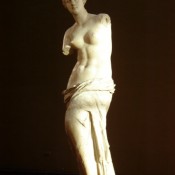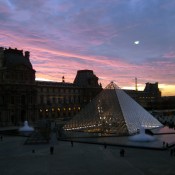Musée du Louvre
- Okay so line ups are long, galleries are crowded, and ticket prices aren't cheap, but hey, are you really going to come all the way to Paris and not check out of the most famous museums in the world? So now that we've established you're going, let's move on.
- The first thing you need to know is a bit of the buildings history, since the site is a work of art in itself. The originally building was constructed in the 12th century as a fortress to protect the city against Northern invaders. The fortress was considerably smaller than what we see today, and instead of works of art the building was used to house the militaries arsenal.
- In the 13th century it became both a fortress and royal home to the King and his court. The King at the time, Charles V, put his stamp on the space by having it enlarged and beautified for it's new royal residence. In 1546 the new King, Francis l, commissioned a serious reno of the building turning it into a modern Renaissance Palace. From that point the functional fortress began it's transformation into what we now know as one of the greatest landmarks in all of Europe.
- We can also thank Francis l for picking up the most popular girl to every take up residence at the Louvre—da Vinci's Mona Lisa.
- In 1589 a new King, Henry lV, connected the main building to the Royal Tuileries with a long addition that runs along the Seine bank, making it the longest building in the world (at the time). The most important part of this historic puzzle piece is who the King invited to live in that addition. Hundreds of artists and crafts people were invited to take up residence on the lower floors of the building, a tradition that would last until Napoleon lll.
- Each King put their mark on the building as years pass, but in 1793, after the French Revolution kicked out the Monarchy, the building opened up to the public as a museum. Although there are many more restorations, renovations, and rejuvenations of the space, from this point on the Louvre begins to grow into what we know today as the most visited museum in the world.
- Today 15, 000 visitors pass through the Louvre each day, and there's plenty of reason why. Over 380, 000 objects and 35, 000 works of art from all corners of the globe are housed here, and it holds some of the most famous works of art in the world, such as the Venus de Milo sculpture, Mona Lisa, and a few from Caravaggio, one of our favorite painters such as Death of a Virgin.
-
The museum is divided into the following eight departments, which are subdivided into many more galleries:
- Egyptian antiquities
- Near Eastern antiquities
- Greek, Etruscan, and Roman
- Islamic art
- Sculpture
- Decorative arts
- Paintings
- Prints and Drawings - Since the collection doesn't extend past the 19th century you'll only find a small selection of modern art.
- Keep in mind it's nearly impossible to see every piece in the museum, which is why so many people return time and time again. Check out some of the tips below our writers who've spent considerable time at the Louvre have put together in the hopes that they can save you a bit of time and inconvenience.
TIPS
- If you really want to see as much of the Louvre as possible in one day, the best days of the week to go are Monday and Wednesdays. On these days the museum is open until 9:45 pm. This will allow you to take your time, but keep in mind a whole day inside even the most beautiful building can be taxing. While touring the galleries take frequent breaks on window ledges and benches if you can score a seat, trust us by the end of the day you're feet will thank you for being so considerate.
- Admission tickets DO allow re-entry, so if you just need some fresh air or to refuel with some grub, you are free to leave and come back as long as it's within the same business day. We found that pre-buying tickets (which can help you avoid the HUGE line ups), and going first thing on a day with extend hours was the best bet. This meant we could spend the morning taking in some great art, take a long lunch, and come back in the evening totally refreshed.
- Don't try to see everything in one day, it won't happen. The best you can do is figure out which exhibits are most important to you and do those first, after that everything else is a cultural bonus.
- Although the first Sunday of every month is free, unless you're on a super strict budget the crowds you'll have to deal with aren't really worth the headache.
- The museum itself is giant and just navigating from room to room can be overwhelming. Make sure you get a map before entering to keep in your pockets incase you run out of time and want to get in a specific room before closing.
- There are audio guides available if you want to learn more about the pieces you're viewing for a small fee, and the museum does guided tours as well if you want to be able to ask questions about certain pieces. If there's something particular you're interested in make sure you ask if it will be covered before purchasing any tour, as you can imagine guided tours can only cover a miniscule portion of art work.
- One thing that we always like to remind everyone is, just because a piece of art is famous doesn't necessarily mean it will move you. The Mona Lisa is pretty under whelming when you actually see it in person, especially after you've fought through the hundreds of people to actually get a decent view. There are many other works in the museum that are underrated but spectacular, so do yourself a favor and explore pieces outside the ones you typically read about in history books, it's about being inspired not scratching works of art off your 'to do' list.
- Log in to post comments
Hours & Location
Musée du Louvre
Sun - Mon: 9:00-18:00
Wed: 9:00-21:30
Thu: 9:00-18:00
Fri: 9:00-21:30
Sat: 9:00-18:00
Wed: 9:00-21:30
Thu: 9:00-18:00
Fri: 9:00-21:30
Sat: 9:00-18:00
- Cour Carrée et Pyramide du Louvre75058 Paris , Paris (75)FrancePhone: +33 1 40 20 50 50









